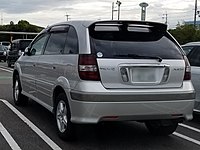
The Toyota Avensis is a mid-size/large family car built in Derbyshire, United Kingdom by the Japanese automaker Toyota from October 1997 to August 2018. It was the direct successor to the European Carina E and was available as a four-door saloon, five-door liftback and estate.
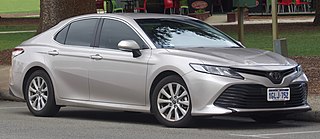
The Toyota Camry is an automobile sold internationally by the Japanese auto manufacturer Toyota since 1982, spanning multiple generations. Originally compact in size (narrow-body), the Camry has grown since the 1990s to fit the mid-size classification (wide-body)—although the two widths co-existed in that decade. Since the release of the wide-bodied versions, Camry has been extolled by Toyota as the firm's second "world car" after the Corolla. As of 2022, the Camry is positioned above the Corolla and below the Avalon or Crown in several markets.
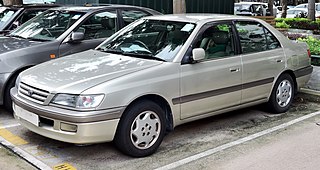
The Toyota Corona is an automobile manufactured by the Japanese automaker Toyota across eleven generations between 1957 and 2001. On launch, the Corona was Toyota's second-highest product in their range, just below the Crown. The Corona was marketed in the JDM at Toyota's Toyopet Store dealership channels, and the Corona was one of Toyota's first models exported to other global markets, followed by the smaller Toyota Corolla.

The Toyota AZ engine family is a straight-4 piston engine series. The AZ series uses an aluminium engine block with cast iron cylinder liners and aluminium DOHC cylinder head. The engine series features many advanced technologies including slant-squish combustion chambers, offset cylinder and crank centers, and the VVT-i continuously variable intake valve timing system. The aluminium engine measures 626 mm (24.6 in) long, 608 mm (23.9 in) wide, and 681 mm (26.8 in) tall.

The Toyota Wish is an automobile produced by the Japanese automaker Toyota from 2003 to 2017. It is a compact MPV with standard three-row seating, and was positioned between the Corolla Spacio and the Ipsum in Toyota's minivan lineup. In Japan, it was available at Toyota Netz dealerships.

The Toyota Carina is an automobile which was manufactured by Toyota from December 1970 to December 2001. It was introduced as a sedan counterpart of the Celica, with which it originally shared a platform. Later, it was realigned to the Corona platform, but retained its performance image, with distinctive bodywork and interior — aimed at the youth market and remaining exclusive to Japanese Toyota dealerships Toyota Store. It was replaced in Japan by the Toyota Allion in 2001 and succeeded in Europe by the Toyota Avensis.
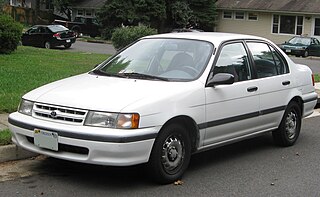
The Toyota Tercel is a subcompact car manufactured by Toyota from 1978 until 1999 across five generations, in five body configurations sized between the Corolla and the Starlet. Manufactured at the Takaoka plant in Toyota City, Japan, and sharing its platform with the Cynos and the Starlet, the Tercel was marketed variously as the Toyota Corolla II — sold at Toyota Japanese dealerships called Toyota Corolla Stores — and was replaced by the Platz in 1999. It was also known as the Toyota Corsa and sold at Toyopet Store locations. Starting with the second generation, the Tercel dealership network was changed to Vista Store, as its badge engineered sibling, the Corolla II, was exclusive to Corolla Store locations.

The Toyota Caldina is an automobile manufactured by Toyota for the Japanese market from 1992 to 2007. It replaced the Corona and Carina wagons, and was sold at Toyota Store and Toyopet Store locations in Japan. While the Caldina has never been officially exported by Toyota, its All-Trac 4WD capability and large capacity have made it a popular grey import in Australia, New Zealand, Russia and many South American countries. When it was discontinued in 2007, the T270 series Avensis wagon/estate assumed its market position.

The Toyota Noah is a minivan with two rear sliding doors built by Toyota and sold mainly in Asian countries. It is positioned below the Alphard, and above the Sienta. The Noah was also positioned below the Estima until the latter was discontinued in 2019.

The Toyota Ipsum, Picnic, or Avensis Verso is a car produced by the Japanese carmaker Toyota from 1995 to 2010. It is a compact MPV with standard three-row seating. The Ipsum, like many Toyota products, was shared as a trio of the Toyota Gaia, and sold only at Japanese Toyota dealerships called Toyota Store, next to the Toyota Carina. The Gaia was unique to Toyopet Store locations, and the Toyota Nadia was sold at Toyota Corolla Store.

The Toyota Auris is a compact car derived from the Corolla, manufactured and sold by Toyota. Introduced in 2006, the first generation three/five-door hatchback shared the platform with the E150 series Corolla, while the second generation five-door hatchback and station wagon called "Touring Sports" uses the E180 platform. The "Auris" name is based on the Latin word for "gold", "aurum".
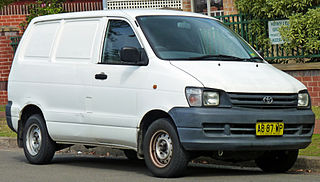
The Toyota LiteAce and TownAce are a line of light commercial and derivative passenger vans produced by the Japanese car manufacturer Toyota. These vehicles originally utilized the cab-over-engine configuration, although since 1996 a semi-cab-over arrangement has featured instead. The LiteAce launched in 1970 as light-duty truck, with commercial and van/wagon body variants added in 1971. In 1976, Toyota released the larger TownAce van/wagon that derived from the LiteAce; a TownAce truck arrived later in 1978. Between 1982 and 1992, the series accommodated the MasterAce Surf—an upscale TownAce passenger wagon.
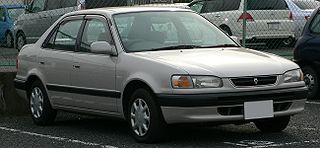
The Corolla E110 was the eighth generation of cars sold by Toyota under the Corolla nameplate.
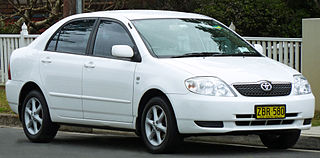
The Toyota Corolla (E120/E130) is the ninth generation of compact cars sold by Toyota under the Corolla nameplate. In Japan, this series arrived to the market in August 2000; however, exports were typically not achieved until 2001 and 2002 depending on the market.

The Toyota Mark II Blit is a mid-size station wagon manufactured by the Japanese automaker Toyota. It is the replacement of the Mark II Qualis and shared a platform with the X110 series Mark II rear-wheel drive sedan, while the Mark II Qualis is a rebadged XV20 series Camry Gracia wagon, with front-wheel drive layout. The Mark II Blit was introduced in January 2002 and ended production in June 2007 due to consolidation efforts. The car remained in production until three years after the Mark X came out, which replaced all of Toyota's X-body sedans, the Verossa, which in turn is a successor to the Chaser and the Cresta, and the Mark II. Toyota's official Mark II Blit successor is the front-wheel drive minivan, the Mark X ZiO, from September 2007. The Mark II Blit marked the return to the Mark II platform with rear-wheel drive layout with optional four-wheel drive and not a wagon version of the front-wheel drive Camry. The car was given a minor facelift in December 2004, including changes to the headlamps, grille and taillamps, which are replaced with LED units. The Mark II Blit uses six-cylinder engines with an optional turbocharger that was discontinued in May 2006, as a result of Japan's emission standards in 2005. The engines used were the 2.0 L 1G-FE, 2.5 L 1JZ-FSE, 2.5 L 1JZ-GE, and 2.5 L single-turbocharged 1JZ-GTE.

The Toyota Gaia is a Japanese market MPV that competed with the Nissan Prairie, Mitsubishi Chariot and the Honda Odyssey. It was replaced by the Toyota Isis. The Gaia shares a platform with the Toyota Ipsum and Toyota Caldina. It was manufactured from May 1998 until September 2004 for the Japanese market. The Gaia was sold only at Japanese dealerships called Toyopet Store next to the Corona.

The Toyota Corolla Spacio is a compact MPV sold by Toyota under the Corolla nameplate. The "Spacio" nameplate was only used in Japan, where it was exclusive to Toyota Corolla Store dealerships. From 2001 in Europe, the second generation Corolla Spacio used the Corolla Verso nameplate instead.

The Honda Odyssey is a minivan manufactured by Japanese automaker Honda since 1994, marketed in most of the world and currently in its fifth-generation.

The E170/E180 series Toyota Corolla is the eleventh-generation of the Corolla that has been sold internationally since 2013. Two basic front and rear styling treatments are fitted to the E170—a North American version that debuted first—and a more conservative design for all other markets that debuted later in 2013. For the Japanese and Hong Kong markets, the smaller and unrelated E160 model is offered instead; the Japanese version remains compliant with Japanese government dimension regulations. The E170/E180 has an increased wheelbase that is 100 mm (3.9 in) longer than the previous generation. The E170/E180 derives from the Toyota New MC platform, unlike the E160 based on the B platform.




